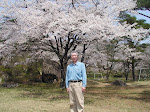.JPG)
.JPG)
I happened to see cosmoses blooming along the river bank in Akita and wrote haiku that day.
Let cosmos
bloom in their own ways
the wind blowing
風そよぐ咲けよコスモス爛漫と
Kaze soyogu sake yo kosumosu ranman to
The cosmos
expressing themselves ―
symphony
コスモスの表す世界調和かな
Kosumosu no arawasu sekai chowa kana
― Hidenori Hiruta



